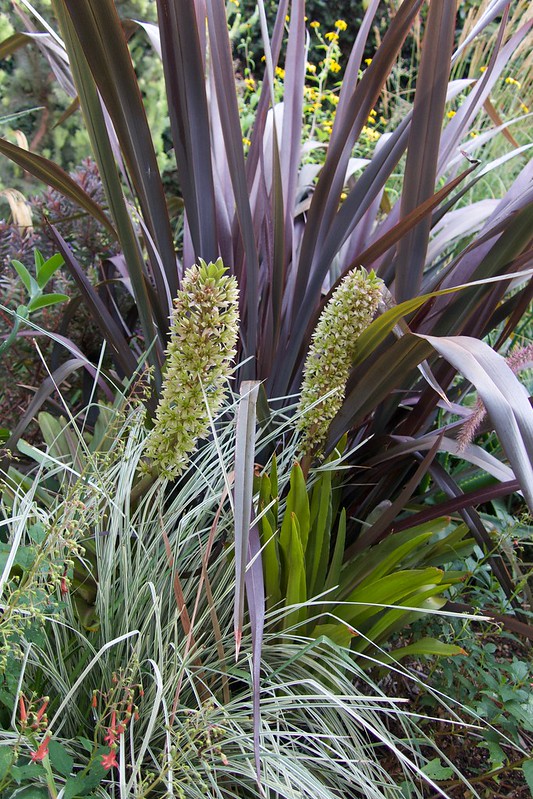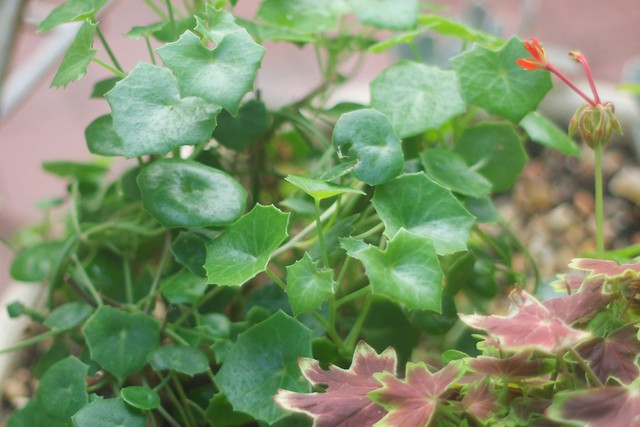“When we sow a seed, we plant a narrative of future possibility,” Sue Stuart-Smith, a British psychiatrist and psychotherapist and wife of garden designer Tom Stuart-Smith, writes in her new book, “The Well-Gardened Mind.” (The New Yorker 8/24/20 “The Therapeutic Power of Gardening“).
Taking that quote probably further than necessary, I’ve got so many narratives going in multiple seed trays, that I wasn’t sure I could keep their stories straight and feared the high temps would close the book on some of them. Some are more precious to me than others, e.g. I’d be a wreck if I lost all the tiny seedlings of Verbascum epixanthinum, which might be the chartreuse-leaved verbascum I grew many years ago. So far, with strict labeling and moving the trays into the shade in the hottest part of the day, we’re doing OK. It’s all very exciting, but I much prefer it when the plants handle this on their own, this question of when and where to set down roots. Writing their own stories, so to speak, without my ghostwriting help, like this glaucium that seeded into the bricks this spring. I really should have edited it out because the pathway has shrunk by a foot, but look at it this morning. What a storytelller!
It’s nice to have around some plants that really seem to enjoy this hot, muggy, steamy August, like amaranthus and a celosia I ordered from Annie’s Annuals a couple weeks ago.
Eucomis ‘Sparkling Burgundy’ blooms are fabulously presentable for a long period of time, even into the dog days of August. They remind me slightly of eremurus, the foxtail lilies, though of course short and squat versions. From the New Yorker article quoted above, I can sympathize with writer Rebecca Mead’s dazzled reaction on seeing eremurus for the first time in Tom Stuart-Smith’s garden: “In the dense bed of plants before us, thin stems topped with clinging bursts of delicate pastel flowers—orange, pink, yellow—had grown to twice the height of their neighbors, looking like slender sticks of licorice dipped in sherbet. “They are foxtail lilies,” Tom explained. “They are from Kazakhstan. Aren’t they great?” Yes, they are! But not suitable for zone 10, unfortunately, whereas eucomis seem fairly happy here. I need to decide whether to keep them in containers or try again planting in the ground. I think it will be containers because past experiments in the ground produced flabby, miserable specimens.
With the cosmos, gomphrena, and now Autumn sage hybrids in bloom, I’ve got a garden fantasy going this August that I’m calling Wildflowers in the Desert. I had a couple rooted branches of Peruvian Apple Cactus, Cereus repandus, one in a pipe, and slipped them into the garden to expand on the theme. I love the heft and thick line that they add to the sesleria grass and rosette-shaped succulents. This cactus grows much too large to plant in the ground but it’s fun to play around with, and I notice flower buds are forming on the branches.
Have a great weekend and stay safe out there, especially friends near the wildfires in Northern California.













Plants that thrive the hot, dry periods like this one are treasures. I planted a 6-pack of that very same Amaranthus a couple of weeks ago. I’ve noticed a couple with the biscuit-colored flowers making their first tentative appearance but was really surprised to find that the pink variety I grew last year self-seeded. I’ve yet to have success with Eucomis – all I can say of mine is that the plants haven’t died after 3 years in the ground but I’ve yet to see flowers. Your variegated Manihot is wonderful – I need to see if my plain-Jane variety is still showing above ground or whether it’s invoked its annual heat-avoidance strategy and gone underground.
Love the close up of the glaucium. The wavy edges look like a giant clam shell. We are in the ‘dog days’ of summer where everything is dry and demanding water. I too appreciate those plants that put themselves in the perfect spot so they don’t require any extra help from me. Hope the fires are far away.
@Kris, I’m going to keep my eucomis in pots since I had the same experience as you when they’re planted in the ground. That amaranthus is also in a big 3-gallon pot…it loves the heat but also some moisture!
@Elaine, we’re babysitting a German shepherd across the street for a couple days. She’s a long hair variety, and poor thing, really brings home the phrase “dog days”! Stay cool!
The Drimia maritima is a great sub for Ermurus, I thought.
My Glaucium simply won’t bloom. The ripples of the leaves are fun to study. Had a single flower bud at purchase several years ago, and it hasn’t flowered since. Not a problem–the foliage is wonderful–just curious as to why it won’t. Plenty of sun–all day long.
I might suggest Kniphofia thompsonii as a similar look to the Eremurus, but they can be a spacial thug in a small garden but do reward with 4 to 6 months of continuous bloom.
@Hoov, as far as drimia, I simply don’t have the room for that enormous bulb and fitting in its on/off season ways. So weird about your glaucium — talk about gardens being regional!
@David, I keep hearing about the long-blooming abilities of that kniphofia and have tried it periodically. I think it was last fall I went all in on five plants and got the same result here in zone 10 — they run at the root like crazy but don’t flower! I got flowers right after planting and then very sporadic and thin bloom. Keep the suggestions coming!